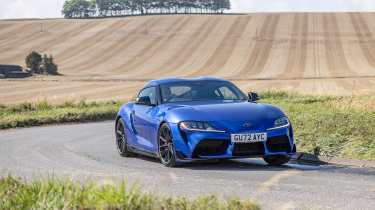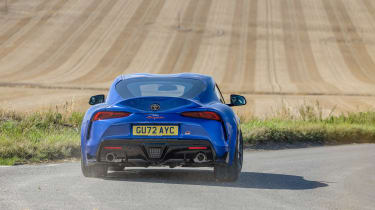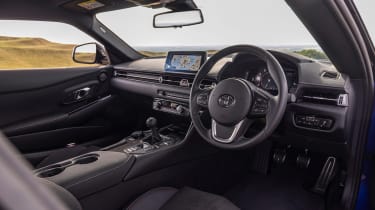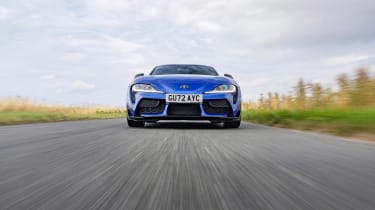Toyota GR Supra manual 2022 review – a six-speed manual gearbox makeover
Can an ‘intelligent’ manual transmission and a sharpened chassis be the making of the 3-litre Supra?
Let’s start with the Toyota GR Supra’s gearknob and work back. Key statistic: it weighs a chunky 200 grams. There’s a reason for this. Having done all the hard work in devising and installing a bespoke six-speed manual gearbox for a car with BMW-sourced mechanicals probably only ever intended to be used with its perfectly fine eight-speed paddleshift auto, the TGR engineering team hit one final snag. The feel of the gearchange wasn’t quite right. Nicely weighted but just a touch sticky. Back to the drawing board? Not really. They tried a heavier gearknob. Things improved but hot-knife-through-butter still wasn’t happening. Finally, the full 200g job for optimum ‘inertia effect’. Actually, forget hot knives… the stickiness had been erased by the extra moving mass of the definitive gearknob iteration. Good enough, job done.
The moral of the story? Don’t overthink it – sometimes, the simplest solutions are the best. Or maybe, by this time, the engineers wanted an expedient fix for a small subjective surfeit of friction that might otherwise taint an engineering endeavour to be proud of. It’s hard to shake the impression that but for customer coercion, Toyota would have been happy to leave the flagship GR Supra, with its turbocharged 335bhp 3-litre straight-six/eight-speed auto BMW Z4 powertrain, well alone, especially as there was no manual option for the Z4 to conveniently pinch. Instead, the company has made a point of giving credit for the manual’s existence to pressure from customers and fans of Toyota’s senior coupe, even though it’s a conveniently comfortable fit with the driver-centric GR message and provided the opportunity to throw some chassis tweaks and lightening regimes into the mix.
More reviews
Group tests
In-depth reviews
Long term tests
Reviews
With nothing oven ready in the Toyota transmission parts bin that could cope with the 3-litre Supra’s 369lb ft, the engineering team cherry-picked the components they needed to tailor a manual six-speeder that would suit the Supra’s muscular mien. In the initial stages the project modified the existing transmission housing, driveshaft and gear set while jettisoning other elements to save weight, the deletion of the ‘acoustic package’ and resulting small increase in transmission whine considered acceptable given the more sporting context.
As with the ’box in the GR Yaris, the Supra’s has an ‘intelligent’ software package – hence ‘iMT’, for intelligent manual transmission – designed to react to a more assertive driving style by optimising engine torque on upshifts at the moment of clutch engagement and release and, yep, matching revs on downshifts, too. On firing up, iMT is enabled as the default, but it can be switched out in Sport mode. Either way, fat gobs of torque are heading the way of the clutch, which has accordingly been equipped with a large friction area and strong diaphragm spring to take the strain.
Compensating for having two fewer ratios than the auto and to ensure a comparably brisk step-off from rest, the final drive has been dropped from the automatic’s 3.15 to 3.46, though the auto is still fractionally quicker to 62mph at 4.3sec to the manual’s 4.6sec.
Introduced for the manual but shared with the auto models from now, chassis mods include stiffer front and rear anti-roll bar bushes plus retuned dampers and power steering. With the sportier – potentially snappier – set-up, the vehicle stability control (VSC) has been teamed with an anti-roll programme (ARP) to intervene earlier for both manual and auto if left on. Specific to the manual, though, the traction control has been tweaked to smooth out the jarring inputs possible with a manual clutch but, in Track mode, still permits some nursery slope-level drifting.
This promises to be a more enticing prospect than before, as the manual, in £53,495 standard trim, weighs a useful 38.3kg less than the previous automatic model. As well as the lighter transmission, helping to shed the kilos are new 19-inch alloys, a slimmed down (ten-speaker) audio system and the loss of the seats’ leather upholstery, power adjustment and lumbar support. But for those less keen on lean, there’s always the £55,995 Pro version, which reinstates the power-adjustable seats with leather upholstery, 12-speaker JBL audio system and adds a head-up display and LED dual-beam headlights into the bargain.
An initial tenure on track isn’t so much a deep dive into the GR Supra’s newly minted assets as a 30-second high-pressure cold shower. Bracing nonetheless and it sorts out a few things. First, the cabin’s as pleasant a place to be as ever, the new centre console putting the stubby gearlever and its 200g knob in exactly the right place with no danger of punching the air conditioning controls. Second, accelerating hard out of the pitlane, the gearbox is right on side, treating road-tester grade aggression and great slabs of torque flung at the rear wheels with nary a flinch, the iMT software cushioning the chassis from even the punchiest Top Gun: Maverick style inputs. Shift quality is robust and positive rather than slick and speedy but it isn’t sticky and it doesn’t baulk. The medium-weight clutch is all sweetness, too.
With the electronic aids doing their thing, there’s a pretty foolproof fusion of grunt and grace, the lighter GR Supra serving up lots of grip and disguising its weight effectively. If not brimming with feel, the steering is direct and accurate, turn-in tenacity something you can really lean on, and jumping back on the gas early post-apex causes no grief. Neither, for the most part, does dialling down the nanny intervention, though a smooth approach is definitely the way to go and finessing balance with helm, throttle and brake a more rewarding policy than trying to flambé the rear tyres.
On the road, its ride isn’t busy or inconsistent, rather it’s smooth and considered. The steering is heavy, and also slower in its rate of response than lots of modern sports cars. There’s certainly more maturity and the very act of changing gear brings immediate involvement, but I can’t help feeling it’s all a bit too measured. Perhaps even tipping over into detachment. The Supra does everything you ask of it and is pleasingly taut and accurate but there’s very little in the way of feel. The body language of the car is more conventional than the stance, proportions and sports car aspirations would suggest, too.
The Supra has an e-diff at the rear and this revised car has a couple of new electronic features, too. The Hairpin+ feature allows more wheelspin on tight uphill corners (not much use in Bedfordshire) and the new Anti-Roll programme actually makes the stability control system step in earlier in the stiffer Sport mode to counter the danger of sudden oversteer. And yet there’s always something pulling it back just enough to interrupt the enjoyment. The engine isn’t as fiery at the top end as the same units found in its BMW cousins. The rear axle still becomes very unsettled over bumpy roads, even the balance itself feels safer and more conservative. The car is just less alive to throttle and braking inputs.
If you do breach the limit, the Supra is very easy to bring neatly back into line, but it doesn’t feel hugely enthusiastic about being overdriven. There are glimpses of brilliance but there’s just not enough detail, enough texture zinging through the seat and steering. The brakes remain fantastic and there’s no lack of grip, but the suspension struggles to keep the wheels in contact with the surface. The Supra’s natural comfort zone is some way behind that lovely engine’s capability or the ultimate grip of the Michelin tyres.
So is the GR Supra transformed? Not exactly. But a welcome attitude adjustment all the same.
Prices and rivals
Toyota's existing GR Supra range in the UK was recently reduced to just the 'Pro' versions at £49,495 and £57,495 for the 2.0 and 3.0 models, but along with the MY23 changes that come alongside the Manual's introduction, we could once again see the full range reintroduced. As mentioned above, the 6MT starts at £53,495 for the base car, and £55,495 for the Pro – a £2000 reduction on the existing automatic.
At this price point, it comes as a little of a shock to see the variety of sports car rivals that persist despite the doom and gloom associated with the future of the sports car. As such, if you want something smaller, lighter and more French, the Alpine A110 is available from £49,990, or around £10k more for the more potent GT and S models. Lotus's £59,995 Emira will be available from Spring 2023 after the initial batch of First Edition cars were sold through, while Audi's TT RS is another option from £60,025.
But the Supra's biggest issue comes from Stuttgart, where the evergreen Porsche 718 Cayman offers its magic at varying price points. The entry-level four-cylinder models migh lack a brilliant engine, but offer an unmatched driving experience. From £68,000 (an admittedly big jump over the Supra) the GTS 4.0 is the real superstar though, matching those superb handling traits to a stunning naturally aspirated six-cylinder motor.
Toyota GR Supra MT specs
| Engine | In-line 6-cyl, 2998cc, turbocharged |
| Power | 335bhp @ 5000-6500rpm |
| Torque | 369lb ft @ 1600-4500rpm |
| Weight | 1502kg (227bhp/ton) |
| 0-62mph | 4.6sec |
| Top speed | 155mph (limited) |
| Basic price | £53,495 |






